Tackling Invasive Species on the Almond
In autumn 2022, the Scottish Invasive Species Initiative were approached by Perth and Kinross Council to work on a project tackling invasive species on the River Almond, a tributary of the River Tay. Hannah Wilson from Perth and Kinross Council has been leading the project, alongside SISI Project Officer Mark Purrmann-Charles, and has written about her experience implementing the SISI model.
The River Almond Invasive Non-Native Species (INNS) project is an ambitious partnership project aiming to bring invasive species on the Almond under control to protect and preserve our native flora, riparian habitats and freshwater ecosystems. The primary focus of the project is the eradication of giant hogweed, but also covers American skunk cabbage, and Japanese knotweed.
Hannah Wilson, Climate Change Land Restoration Officer with Perth and Kinross Council, has been leading the River Almond INNS project alongside SISI Project Officer Mark Purrmann-Charles.
Hannah spraying giant hogweed in 2023.
The project was developed through the Tayside Biodiversity Partnership, Perth and Kinross Council, and the Scottish Invasive Species Initiative agreeing to work in partnership to control the growing threat posed by invasive species on the Almond. Perth and Kinross Council funded this project through the Scottish Government’s Nature Restoration Fund. One of the main themes of the fund is control of invasive non-native species, so this project fit the criteria nicely.
Whilst Perth and Kinross Council do control INNS, we have not undertaken catchment scale control of a river system before, as this requires significant resources and a strategic, multi-stakeholder approach.
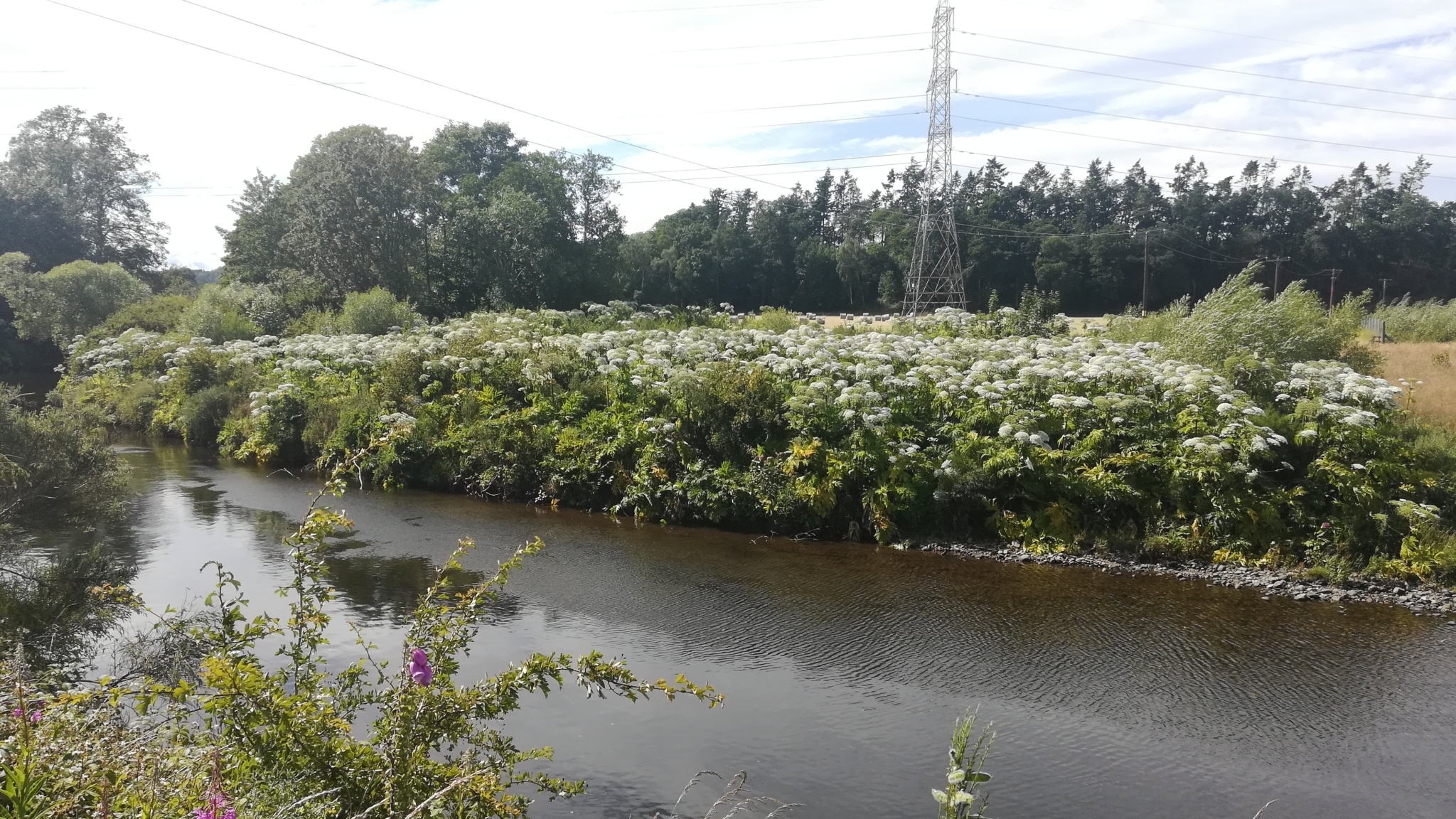
Bertha Park site in 2022 before control started.
The River Almond has been infested with giant hogweed for many years. The above photo shows the Bertha park bridge site in 2022, one year before control work began. A top-down approach is required to tackle the issue and eradicate the plant for good.
When invasive plants such as giant hogweed set seed, the seeds are carried downstream by the water and then settle at different points along the length of the river. Therefore, the most effective method of control for INNS is a top-down catchment-wide approach. If plants at the top of a river catchment are controlled first, it is less likely that new plants will reinfest the river.
By working directly with SISI, we have been able to follow their model of INNS control, engaging and working with all the key stakeholders including landowners, contractors, and local volunteers. By doing so, we have been able to maximise control efforts, working in partnership to treat invasive plant species during the growing season and preventing them from spreading further.
Project Delivery
The first step of the project was to survey the river to identify how severe the problem was, and to identify the source of the INNS – with a particular focus on the giant hogweed. The survey work began in November 2022. We split the river into seven sections from Buchanty to Inveralmond and walked each section of the river, keeping our eyes open for giant hogweed and American skunk cabbage. Where we saw it, we marked it down on a map and noted how abundant it was in that area. We also checked the burns running into the river in case the source plants came from them.
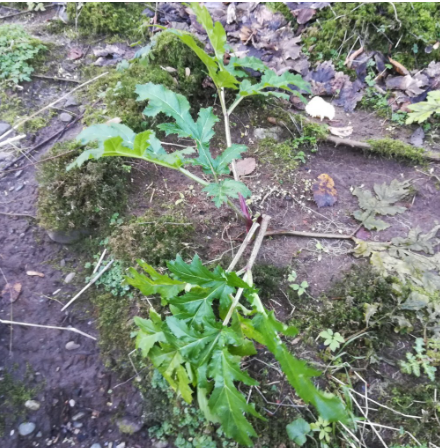
An immature giant hogweed plant found on a winter survey in 2022.
Whilst mature giant hogweed plants are very visible, with large flowerheads in spring/summer, in the winter they can be very small and difficult to identify. In many cases we were able to spot old dead flower heads, where giant hogweed had seeded and died back in previous years. We were able to identify the source of the giant hogweed in Buchanty, and as suspected, the further down the river catchment we surveyed the more severe the infestation became. With surveying complete in winter, we were in a good position to begin control work in early May.
Mapping land ownership
Mapping landownership and getting in touch with landowners was a particular challenge of the project. In order to undertake control work, we first needed to find out who owns the land around the River Almond and then contact them to discuss control works. With the larger landowners we initiated discussions on sharing responsibility for control work in future years.
Perth and Kinross Council’s estates team played a huge role in getting this information for us. We didn’t have any major concerns from landowners, who were happy for us to come and control INNS on their land.
Volunteers
In January of 2023, we put out a call for volunteers to get involved in giant hogweed control via Perth and Kinross Council social media and by sending out letters to residents of Almondbank. We received a great response rate and 35 people registered with SISI to help us.
Seven volunteers were put through pesticide application training in early March.
We had a volunteer meet-up at the end of January to chat through project expectations and training with those who were looking to undergo pesticide application training. In early March we put seven volunteers through the training course which provides the City & Guilds NPTC Level 2 Award in PA1 (safe use of pesticides) and PA6/AW/INJ (handheld applicator i.e. knapsack sprayer and stem injection).
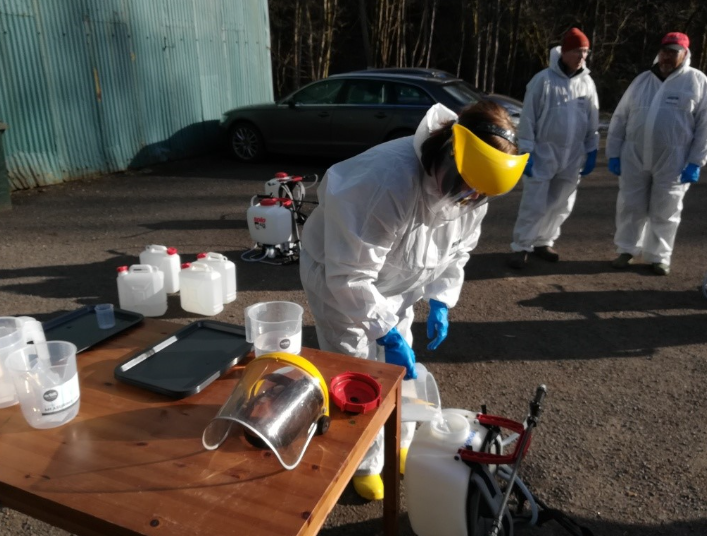
Our volunteers undertaking their pesticide application training in 2023.
As we had such a great response from volunteers we decided to reallocate some of our budget and put more money towards investing in PPE and equipment for volunteers to get out on control days with us.
We held several volunteer sessions on the Almond over the course of May and June 2023, including a volunteer session for INNS week. This was our largest control session, hosting a cohort of eight volunteers at Bertha Park where there was a significant giant hogweed infestation. Over the course of the season volunteers controlled giant hogweed in several different areas of the catchment, including the areas around Millhaugh, Dalcrue, and Almondbank where giant hogweed infestations were severe. The contractors were tasked with the areas that were harder to reach with difficult terrain, in sections further up the catchment.
The infestation at Bertha park was first tackled during Invasive Species Week, with a fantastic team of eight volunteers alongside Hannah and Mark. Several volunteer days were required to fully control the giant hogweed on this site.
Our volunteer team at Bertha Park during INNS Week 2023.
Overall volunteers contributed an impressive 110 hours of control time (over 15 working days!) over the course of the 2023 season, with an additional 70 hours of control time contributed by Hannah and Mark. This gives a grant total of over 25 working days with an additional 6 days of contractor work. This effort has allowed us to bring approximately 22km of river under management in 2023, reaching from the upstream source to the current end point for control just past Bertha Park bridge. We are extremely grateful to our hard-working volunteers, who have put in this time and effort and made the project such a success.
Contractors were deployed on sites further upstream on the River Almond with difficult terrain.
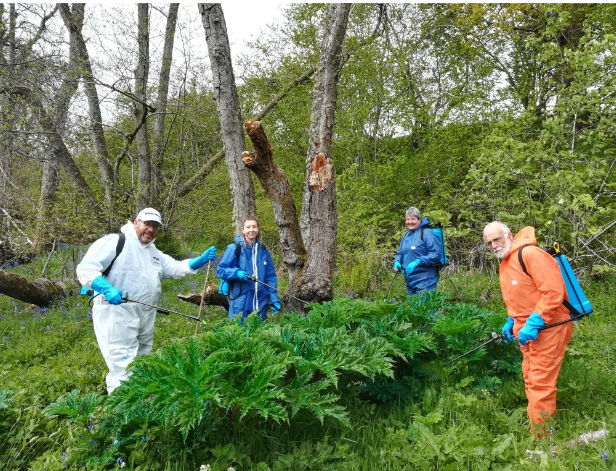
Our volunteers out spraying giant hogweed in 2023.
By investing time and support into building a network of local volunteers, Perth and Kinross Council were able to empower the community to help make Perth and Kinross a better, greener place. Our enthusiastic local volunteers were also able to help monitor the success of our project, reporting back any giant hogweed seedheads that may have been missed, that we then went back to control. In sites with large infestations such as Bertha Park, SISI were able to cut down any remaining seedheads with a long extendable saw, to prevent any plants from setting seed.
We also carried out Japanese knotweed control via several stem injection sessions with our volunteers around the areas of Bertha Park and Inveralmond. Luckily, Japanese knotweed is not as prevalent on the Almond as giant hogweed, so there are fewer areas to control.
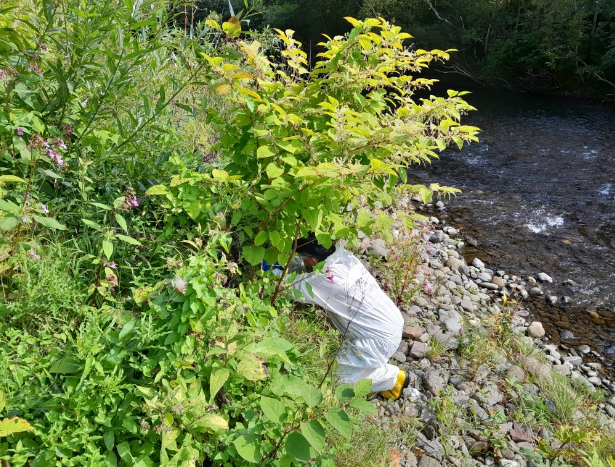
The Japanese knotweed problem is not as bad on the Almond – time to get on top of it before it gets worse!
The control of INNS is a daunting task – carrying out control work over such a large area is time consuming, expensive, and requires strategic planning. By working with SISI and following their model of control, landscape scale INNS control was no longer such a daunting task. With continuous support and advice from Project Officer Mark, we were able to bring a complex problem under control. We have made a very promising start to controlling INNS on the Almond.
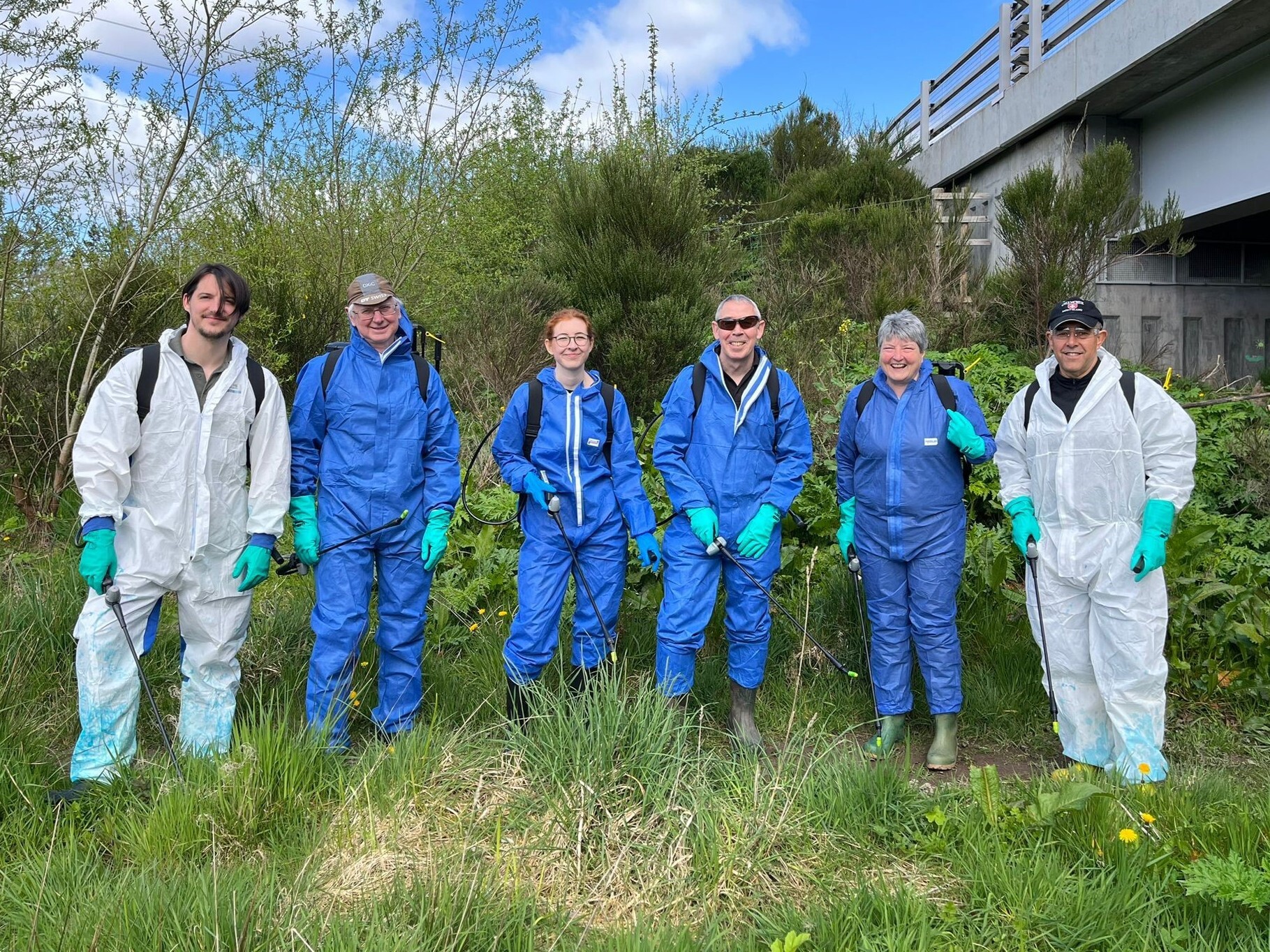
Our first volunteer session of 2024 at Bertha Park.
In 2024 we have brought another 3km of the river under management to expand control all the way to the Tay confluence. We are continuing to follow the SISI model of working in partnership with volunteers and contractors, taking a top-down approach to INNS control.
It is exciting to think what the river will look like in 10 years’ time. With continuous control efforts, our native biodiversity will be thriving once again.
COMMENTS
Other Blogs


Nature Market 2024
In June 2024, a summer market was held to celebrate how we can all help nature. Local businesses, co ...

New Tree Planting Guidance for Communities
Perth and Kinross Council have recently created new guidance for community tree planting. This guida ...

Green Living Fund
Are you a community group looking for funding? The Green Living PB Fund is now open for bids. The bi ...
Earth Day Market 2023
On the 22nd April 2023, community groups, businesses and environmental organisations came together t ...
Earth Day Market 2023
On the 22nd April 2023, community groups, businesses and environmental organisations came together t ...
New Tree Planting Guidance for Schools
Perth & Kinross Council have recently created new guidance for tree planting in schools. This gu ...
